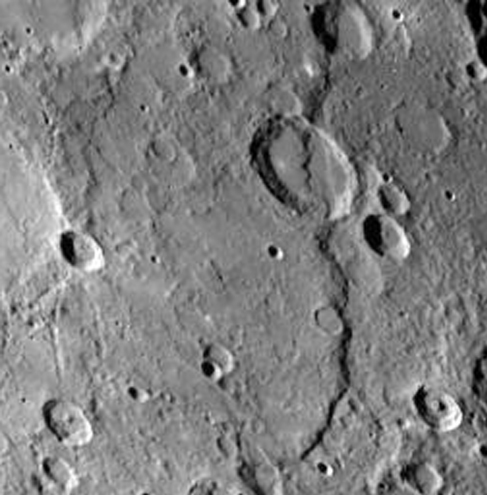| << Chapter < Page | Chapter >> Page > |
If the standard cratering chronology applies to Mercury, this shrinkage must have taken place during the last 4 billion years and not during the solar system’s early period of heavy bombardment.

The problem with understanding how Mercury formed is the reverse of the problem posed by the composition of the Moon. We have seen that, unlike the Moon, Mercury is composed mostly of metal. However, astronomers think that Mercury should have formed with roughly the same ratio of metal to silicate as that found on Earth or Venus. How did it lose so much of its rocky material?
The most probable explanation for Mercury’s silicate loss may be similar to the explanation for the Moon’s lack of a metal core. Mercury is likely to have experienced several giant impacts very early in its youth, and one or more of these may have torn away a fraction of its mantle and crust, leaving a body dominated by its iron core.
You can follow some of NASA’s latest research on Mercury and see some helpful animations on the MESSENGER web page.
Today, astronomers recognize that the early solar system was a chaotic place, with the final stages of planet formation characterized by impacts of great violence. Some objects of planetary mass have been destroyed, whereas others could have fragmented and then re-formed, perhaps more than once. Both the Moon and Mercury, with their strange compositions, bear testimony to the catastrophes that must have characterized the solar system during its youth.
Mercury is the nearest planet to the Sun and the fastest moving. Mercury is similar to the Moon in having a heavily cratered surface and no atmosphere, but it differs in having a very large metal core. Early in its evolution, it apparently lost part of its silicate mantle, probably due to one or more giant impacts. Long scarps on its surface testify to a global compression of Mercury’s crust during the past 4 billion years.
Bakich, Michael. “Asia’s New Assault on the Moon.” Astronomy (August 2009): 50. The Japanese Selene and Chinese Chang’e 1 missions.
Beatty, J. “NASA Slams the Moon.” Sky&Telescope (February 2010): 28. The impact of the LCROSS mission on the Moon and what we learned from it.
Bell, T. “Warning: Dust Ahead.” Astronomy (March 2006): 46. What we know about lunar dust and the problems it can cause.
Dorminey, B. “Secrets beneath the Moon’s Surface.” Astronomy (March 2011): 24. A nice timeline of the Moon’s evolution and the story of how we are finding out more about its internal structure.
Jayawardhana, R. “Deconstructing the Moon.” Astronomy (September 1998): 40. An update on the giant impact hypothesis for forming the Moon.

Notification Switch
Would you like to follow the 'Astronomy' conversation and receive update notifications?